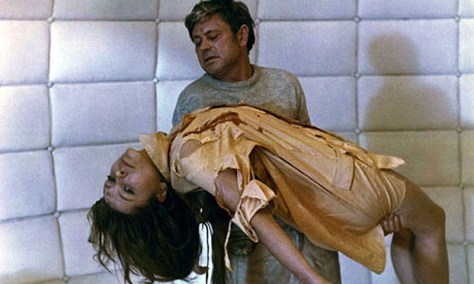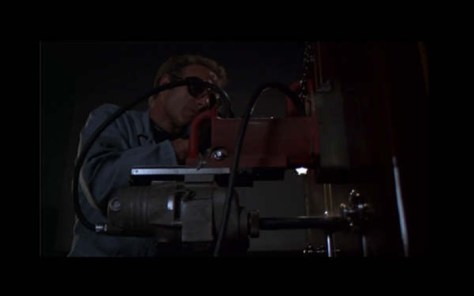
As part of their current ‘Gothic’ season and regular Sonic Cinema strand, the BFI presented a night of Gothic-inspired sounds and images on 13 December 2013, curated by the artist and composer Robin Rimbaud, aka Scanner. The evening opened with Chris Turner’s fashion film G(O)OD+(D)EVIL, which slickly plays with horror imagery, and features a dark ambient score by Scanner. This was followed by an astonishing musical show by Gazelle Twin, introduced by a disquieting short film featuring the performers in a supermarket. Wearing a wig and a blue hoodie, her face disguised by tights, Gazelle Twin was accompanied by two musicians in red hoodies providing the sounds and beats on laptops. They looked like strange faceless creatures in the semi-darkness, not unlike the demonic East End figures of Philip Ridley’s Heartless (2009); the creepy, haunting vocals, ghostly melodies, doom-laden bass lines and mesmeric, intricate beats created an intensely immersive, obsessive soundscape. After such a powerful performance, Anna and Maria von Hausswolff’s Trace the Spark was a bit of an anti-climax. A by-the-numbers experimental short film consisting of split-screen abstract imagery that repeated and mutated to a drony soundtrack, it was fairly unsurprising, and failed to make truly inventive or interesting connections between the sounds and the images.
Giving the event its name, Scanner then performed his take on Lachrimae, exploring the musical variations on the theme of tears, developed by 17th-century English musician John Dowland. The work is a collaboration between Scanner and Chris Turner, who provided the visuals: a black and white short film showing an attractive woman moving in slow motion. The film was as glossy and empty as an advert, but the music was captivating and hypnotic, and loosely in sync with the images. Starting with a beautiful melody punctuated by menacing bass lines and cascading percussive noises, it turned into lone piano notes contrasted with explosive sounds, underpinned by a quieter repetitive sequence full of whispers, before growing into higher-pitched sounds that evoked wrecked spaceships drifting through dark skies.
The final act, and the undeniable highlight of the night, was Carter Tutti (former Throbbing Gristle members Chris Carter and Cosey Fanni Tutti), who performed their score to an extract of F.W. Murnau’s Faust (1926). Murnau’s images remain dazzlingly magical, and Carter Tutti’s score matched them with remarkable precision and imagination, making it the finest instance of visual and sonic concordance of the night. The ominous drone and industrial noises incorporated sounds of explosions, a crowd, wind blowing, a heartbeat, all of which directly matched specific visual events, while evocative whispers and flowing water, weeping violins and dissonant cellos underscored the mood of the scenes. The seamless way in which one piece of music segued into the next was particularly impressive. It was a mighty, dense performance that uniquely brought out the brilliance of the film and left the audience staggering out into the light, stunned and amazed by the dark wonders they had just witnessed.
Virginie Sélavy









